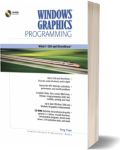Windows Graphics Programming
Software Development
Book Details
Book Title
Windows Graphics Programming: Win32 GDI and Directdraw
Author
Feng Yuan
Publisher
Prentice Hall PTR
Publication Date
2000
ISBN
9780130869852
Number of Pages
1090
Language
English
Format
File Size
5.50MB
Subject
software-development/devops/Computer graphics
Table of Contents
- Start
- Table of Contents
- Book Cover
- Author Biography
- Preface
- 1. Basic Techniques and Knowledge
- 1.1 Basic Windows Programming in C/C++
- 1.2 Assembly Language
- 1.3 Program Development Environment
- 1.4 Win32 Executable File Format
- 1.5 Architecture of Microsoft Windows OS
- 1.6 Summary
- 2. Windows Graphics System Architecture
- 2.1 Windows Graphics System Components
- 2.2 GDI Architecture
- 2.3 DirectX Architecture
- 2.4 Printing Architecture
- 2.5 Graphics Engine
- 2.6 Display Drivers
- 2.7 Printer Drivers
- 2.8 Summary
- 3. GDI /DirectDraw Internal Data Structures
- 3.1 Handles and Object-Oriented Programming
- 3.2 Decoding GDI Object Handles
- 3.3 Locating the GDI Object Handle Table
- 3.4 Decoding the GDI Object Handle Table
- 3.5 User Mode Data Structure of GDI Objects
- 3.6 Accessing Kernel Mode Address Space
- 3.7 WinDbg and the GDI Debugger Extension
- 3.8 GDI Kernel Mode Data Structure
- 3.9 DirectDraw Data Structure
- 3.10 Summary
- 4. Spying in the Windows Graphics System
- 4.1 Spying on Win32 API Calls
- 4.2 Spying on Win32 GDI
- 4.3 Spying on DirectDraw COM Interfaces
- 4.4 Spying on GDI System Calls
- 4.5 Spying on the DDI Interface
- 4.6 Summary
- 5. Graphics Device Abstraction
- 5.1 Modern Video Display Card
- 5.2 Device Context
- 5.3 Formalizing Device Context
- 5.4 Sample Program: Generic Frame Window
- 5.5 Sample Program: Painting and Device Context
- 5.6 Summary
- 6. Coordinate Spaces and Transformation
- 6.1 The Physical Device Coordinate Space
- 6.2 The Device Coordinate Space
- 6.3 The Page Coordinate Space and Mapping Modes
- 6.4 The World Coordinate Space
- 6.5 Using Coordinate Spaces
- 6.6 Sample Program: Scrolling and Zoom
- 6.7 Summary
- 7. Pixels
- 7.1 GDI Objects, Handles, and Handle Table
- 7.2 Clipping
- 7.3 Color
- 7.4 Drawing Pixels
- 7.5 Sample Program: Mandelbrot Set
- 7.6 Summary
- 8. Lines and Curves
- 8.1 Binary Raster Operations
- 8.2 Background Mode and Background Color
- 8.3 Pens
- 8.4 Lines
- 8.5 Bezier Curves
- 8.6 Arcs
- 8.7 Paths
- 8.8 Sample: Drawing Your Own Styled-Lines
- 8.9 Summary
- 9. Areas
- 9.1 Brushes
- 9.2 Rectangles
- 9.3 Ellipses, Chords, Pies, and Rounded Rectangles
- 9.4 Polygons
- 9.5 Closed Paths
- 9.6 Regions
- 9.7 Gradient Fills
- 9.8 Area Fills in Reality
- 9.9 Summary
- 10. Bitmap Basics
- 10.1 Device-Independent Bitmap Formats
- 10.2 A DIB Class
- 10.3 Displaying a DIB
- 10.4 Memory Device Contexts
- 10.5 Device-Dependent Bitmaps
- 10.6 Using DDBs
- 10.7 DIB Section
- 10.8 Summary
- 11. Advanced Bitmap Graphics
- 11.1 Ternary Raster Operations
- 11.2 Transparent Bitmaps
- 11.3 Transparency Without a Mask Bitmap
- 11.4 Alpha Blending
- 11.5 Summary
- 12. Image Processing Using Windows Bitmaps
- 12.1 Generic Pixel Access
- 12.2 Bitmap Affine Transformation
- 12.3 Fast Specialized Bitmap Transformer
- 12.4 Bitmap Color
- 12.5 Bitmap Pixel Transformation
- 12.6 Bitmap Spatial Filters
- 12.7 Summary
- 13. Palettes
- 13.1 System Palette
- 13.2 The Logical Palette
- 13.3 Palette Messages
- 13.4 Palette and Bitmaps
- 13.5 Color Quantization
- 13.6 Bitmap Color-Depth Reduction
- 13.7 Summary
- 14. Fonts
- 14.1 What's a Font?
- 14.2 Bitmap Fonts
- 14.3 Vector Fonts
- 14.4 Truetype Fonts
- 14.5 Font Installation and Embedding
- 14.6 Summary
- 15. Text
- 15.1 Logical Fonts
- 15.2 Querying Logical Font
- 15.3 Simple Text Drawing
- 15.4 Advanced Text Drawing
- 15.5 Text Formatting
- 15.6 Text Effects
- 15.7 Summary
- 16. Metafile
- 16.1 Metafile Basics
- 16.2 Inside an Enhanced Metafile
- 16.3 Enumerating an EMF
- 16.4 An EMF as a Programming Tool
- 16.5 Summary
- 17. Printing
- 17.1 Understanding the Spooler
- 17.2 Basic Printing Using GDI
- 17.3 Design for Printing
- 17.4 Drawing on Printer Device Context
- 17.5 Summary
- 18. DirectDraw and Direct3D Immediate Mode
- 18.1 Component Object Model (COM)
- 18.2 DirectDraw Basics
- 18.3 Building a DirectDraw Graphics Library
- 18.4 Direct3D Immediate Mode
- 18.5 Summary
